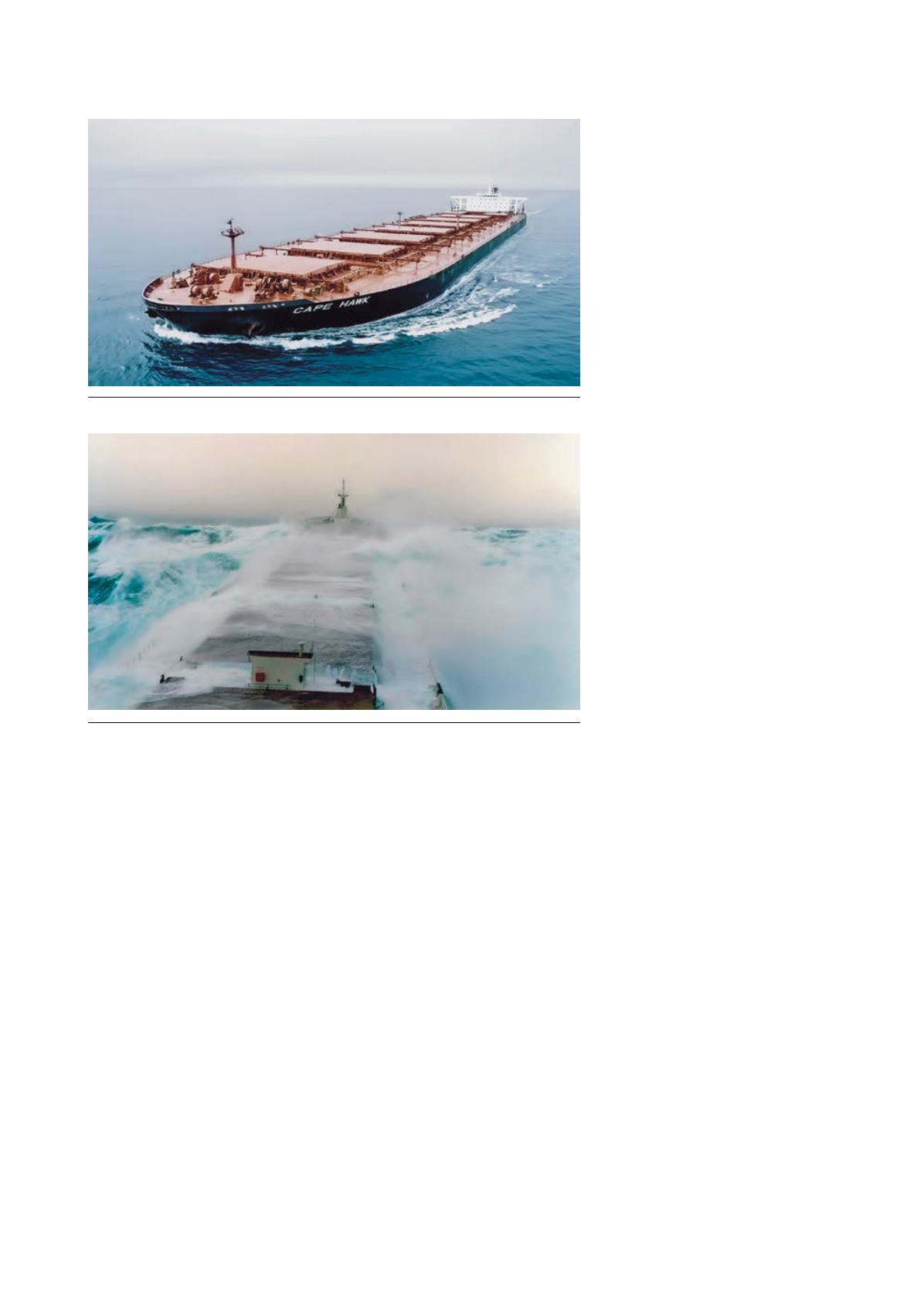
make it less than desirable. Figure 1 is a
typical vessel that would transport coal.
The hatches and hatch covers are very
evident.
Problems on deck
Hatches on the main deck of a vessel
create two problems. The hatches must
be large enough to allow access to load
and unload the holds. The hatch covers
must be sufficiently robust to prevent
deformation and ingress of water even
when subjected to the force of large
breaking waves. To be large enough to
allow sufficient access to a hold, the
hatch must comprise a large percentage
of the total area of the hold. Since the
size and number of holds constitute
most of the weather deck area of an
ocean-going bulk carrier, hatches – and
therefore hatch covers – are a large
percentage of the area of the weather
deck. These requisite large hatches in the
weather deck adversely affect the
structural integrity of the vessel,
requiring the naval architect to add
significant structural reinforcement to
the weather deck. Additionally, large
robust hatch covers add significant
weight, machinery and cost to the vessel.
Sealing large hatches against leakage
is a significant problem. The ocean,
especially during storms, is subject to
large random waves that cause even
large vessels to roll and pitch. The
vessels are made of steel, which
deforms as it is stressed in rough seas.
The hatch covers, not being an integral
part of the vessel, do not deform in the
same manner as the weather deck. In
rough weather, this difference in
deformation makes it difficult to fully
seal the hatches making them subject to
leaks. In very rough weather, the
hatches can also become overstressed
and fail structurally.
It is not unusual to encounter sea
states that cause the bow of a vessel to
submerge, shipping many tonnes of
water aboard the weather deck. If, when
the vessel’s bow is submerged, it is hit
by a breaking wave, very large loads can
be imposed on the hatch covers. When
in storms of this severity, it is also not
unusual for a ship to roll significantly. In
such a storm, the survival of the vessel
may well depend on the security of the
hatch covers and stability of the load.
If a forward hatch cover fails, it is
highly probable the vessel will take on
enough water to sink by the bow. If the
hatch covers leak, it is possible to take
on enough water to partially liquefy the
coal, making it easy for the load to shift
dramatically, changing the trim of the
ship. A ship negotiating a strong storm
at sea on an even keel has little chance
of survival if, due to a shifted load, it
incurs a significant list.
Over the years, ingress of salt water
into areas not easily detected can
corrode and weaken the structure of a
ship. The unloading of a vessel by
means of clamshell buckets and end
loaders or dozers will inevitably
damage the epoxy coating installed on
the inside of a hold to protect against
corrosion. Coal and saltwater are very
effective corrosive agents to
unprotected steel. A vessel weakened
by corrosion may fail structurally
without warning in seas that it would
normally withstand.
Lloyd’s Register, the British
classification society, issued warnings in
1990 and early 1991 concerning dangers
to the ageing fleet of bulk carriers from
corrosion in cargo holds. Some
unexplained losses of large bulk carriers
have occurred within minutes resulting
in the loss of all hands indicating a large
instantaneous rupture of the underwater
hull. This is consistent with weakening
of the hull by corrosion.
Case studies of bulk
carriers lost at sea
The following are excerpts from reports
on bulk carriers lost at sea:
MV Derbyshire
MV Derbyshire
was lost on
9 September 1980 during Typhoon
Orchid, south of Japan. All 42 crew
Figure 1. Hatch covers on weather deck.
Figure 2. Bulk carrier in rough seas.
50
|
World Coal
|
June 2016


